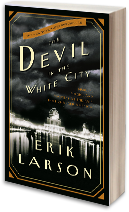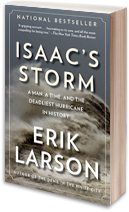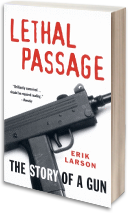The true story of how the lives of the inventor of wireless and of Britain's second most-famous murderer (after Jack the Ripper) intersected during one of the greatest criminal chases of all time. The inventor was Guglielmo Marconi, the young Italian genius; the killer was Hawley Harvey Crippen, who murdered his overbearing wife and fled Britain with his mistress, unaware that Scotland Yard was hot on his heels. The book—an instant
New York Times bestseller—brings to life a host of forgotten characters, including spirit mediums, ghost-hunting physicists, Scotland Yard inspectors, and one of the great pioneers of forensic science. The climax occurs during a trans-Atlantic chase which, thanks to the miracle of Marconi's invention, was followed by millions of people around the world—with Crippen and his mistress completely unaware.
Read More
Murder, Magic, and Madness at the Fair that Changed America
The No. 1
New York Times bestseller about the architect who led the construction of the great Chicago World's Fair of 1893, and the prolific serial killer who used the fair as a lure. Just blocks from the fairgrounds, the killer built a hotel of horrors equipped with an acid vat, dissection table and crematorium. The book won an Edgar Award for best fact-crime writing, and was a finalist for a National Book Award. In November 2010, Leonardo DiCaprio acquired the rights to make a feature film based on
Devil, and has stated he plans to play the role of the killer, Dr. H. H. Holmes.
Read More

A Man, a Time, and the Deadliest Hurricane in History
At the turn of the last century, Isaac Cline, chief weatherman for Texas, believed no storm could do serious harm to the city of Galveston, a fast growing metropolis on the Gulf Coast destined for great things. In September 1900 a massive hurricane proved him wrong, at great personal cost. The storm killed as many as 10,000 people in Galveston alone, stole the city's future, and caused hurricane experts to revise their thinking about how hurricanes kill. The book won the American Meteorology Society's prestigious Louis J. Battan Author's Award. (For the record, of all my books, this is my wife's favorite--EL.)
Read More

The Story of a Gun
When I lived in Baltimore, I became struck by the frequency of drive-by shootings involving young teens who possessed sophisticated weapons. At the time, no one bothered to find out where the guns came from. I decided to try. The result was this book, which tells the story of how a particular model of handgun, designed initially for urban warfare, became the crime-gun of choice for inner-city gangs, and how one such gun came to be in the hands of a Virginia schoolboy who used it to kill a teacher. Only a malfunction in the weapon prevented this incident from becoming one of the worst mass murders of all time. In the course of my research, I became a federally licensed gun dealer and took lessons in shooting for self-defense. I have to say, the shooting was a lot of fun, although I was the only guy in my class and the gleeful laughter of the women around me, as they blasted away at clearly masculine targets, was just a tiny bit disconcerting.
Read More

How Our Private Lives Become Public Commodities
After receiving a sudden surge of junk mail directed at new parents—even though my wife at the time was merely pregnant—I set out to explore the lengths companies go to spy on individual consumers. It was fascinating, and a little scary. For example, I discovered one market-research firm that put human spies in stores to follow every move a shopper made, and another company that secretly commandeered viewers' televisions to show them commercials no one else got to see. The book became the subject of a PBS documentary, "We Know Where You Live," in which yours truly was the main character. I even got to slink around in a trench coat and lurk behind trees.
Read More

